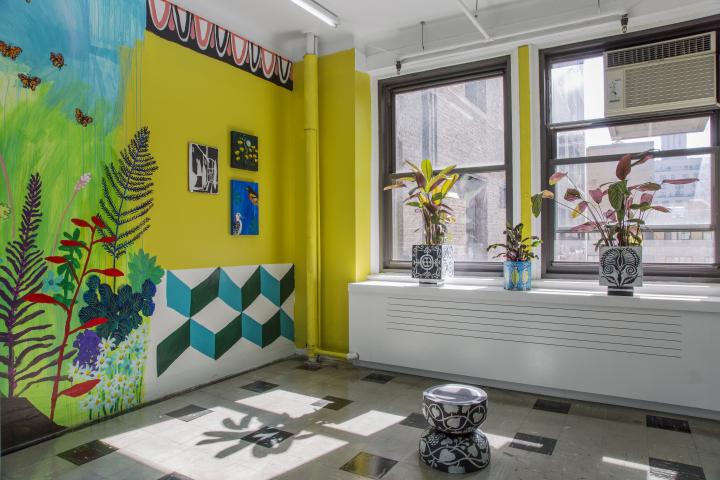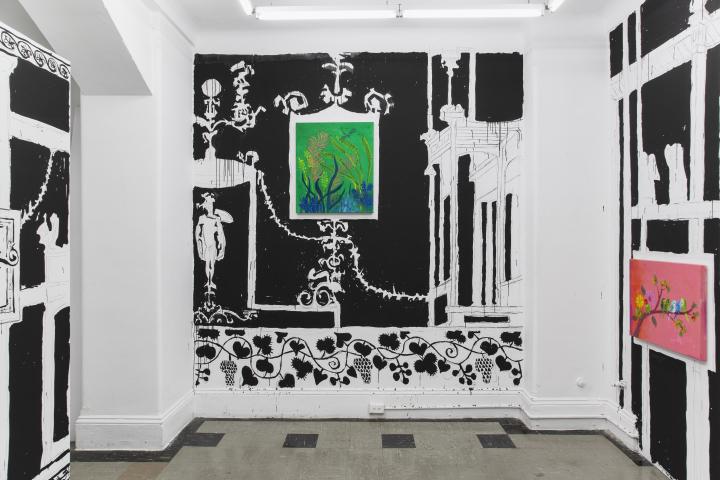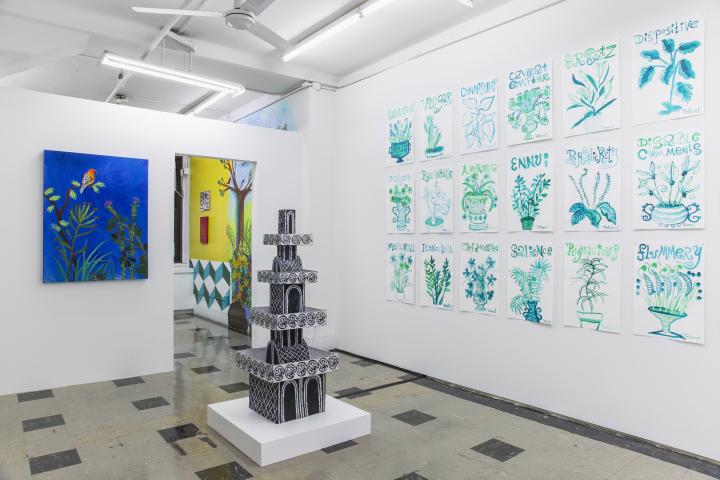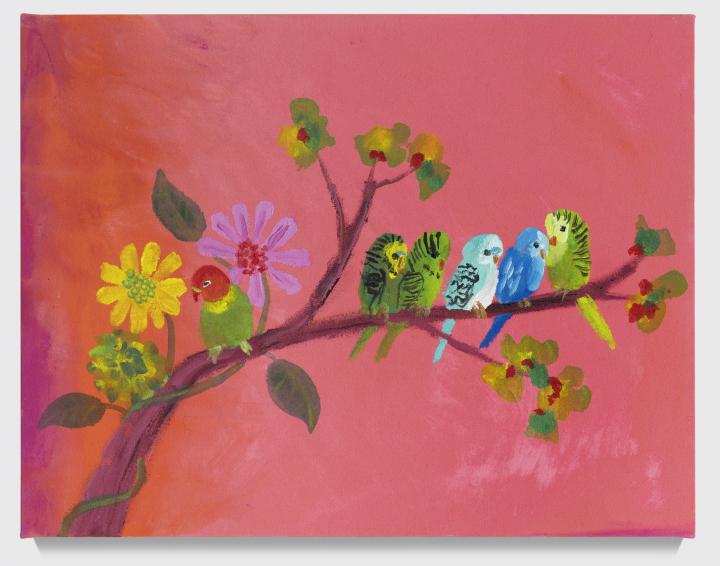November 5, 2019
Download as PDF
View on Hyperallergic
Garden is a sustained mind-meld between two artists’ aesthetic sensibilities, one clearly born from a long friendship grounded in loving, making, and sharing art over the course of 15 years.
Garden: Elisabeth Kley and Tabboo! at Gordon Robichaux is gaudy, ornate, and all the better for it. The site-specific installation by painter and performer Tabboo! (aka Stephen Tashjian) and sculptor Elisabeth Kley brims with the joy of creation, of friends ploughing past received ideas of taste and history to reach the viewer on the level of pure pleasure. In its contained air of hothouse cheer, the artists offer their hands to walk you gaily among the flowers.

Installation view of Garden: Elisabeth Kley and Tabboo! at Gordon Robichaux, New York, 2019 (courtesy Gordon Robichaux, NY, photo by Gregory Carideo)

Installation view of Garden: Elisabeth Kley and Tabboo! at Gordon Robichaux, New York, 2019 (courtesy Gordon Robichaux, NY, photo by Gregory Carideo)
The show is a sustained mind-meld between Tabboo!’s and Kley’s aesthetic sensibilities, one clearly born from a long friendship grounded in loving, making, and sharing art. Over the course of 15 years, they have formed the kind of creative relationship where one inspires the other to a thrilling snowball effect: photographs influence drawings that become sculptures that inform set design, and so on.
Both artists are drawn to what’s most outsized, colorful, and performative about visual culture and what’s most expressive, emotional, and generous about surfaces. Garden isn’t cool and ironic like a Warhol painting or empty and kitsch like a Koons sculpture; it’s exciting, openhearted, and sweetly human. In its homey maximalism, the show fulfills its titular function: giving the viewer space to bask in its dazzling color.
Garden isn’t so much an ode to nature as to an apartment. According to exhibition texts, both artists found inspiration in the jungle of potted plants that snakes through Tabboo!’s flat on the Lower East Side. In this way the show represents an exploded view of the artists’ interior spaces — a free pass to walk around Kley’s and Tabboo!’s minds, enjoy their references, and be dazzled by their intelligence and good humor.
As complementary as their visions can be, their signatures are distinct. Kley’s oeuvre is steeped in her love for historical craft, the intricacies of Old World textiles, and the flamboyance of palace gardens. Her sculptures distill all that’s great about Ancient Roman, Asian, and Arab designs through the lens of an irreverent New Yorker. The results are animated by a very specific kind of humor, privileging nothing but flair.
The ultra-colorful glazes on Kley’s stools and planters remind me of campy talavera homeware and Dalí’s foray into ceramics, while her painted trompe-l’œil walls are evocative of palazzos at night. But her defining works here are two functioning earthenware fountains — “Fountain with Arches and Nautilus Border” and “Fountain with Crescents and Leaves” — that succeed more than anything else on view in establishing the show’s lush and absurd sense of place.
Tabboo! is a wildly underrated New York icon, a foremother of the 1980s art world and ’90s drag scene and the rare cult figure who can claim both Nan Goldin and RuPaul as his peers. With his signature scrawl and subcultural roots, he’s easily the equal of Raymond Pettibon. Beyond their graphic influence on music and fashion, both share a similar approach to culture, turning pop iconography over in their hands for all of its psychic resonance.

Installation view of Garden: Elisabeth Kley and Tabboo! at Gordon Robichaux, New York, 2019 (courtesy Gordon Robichaux, NY, photo by Gregory Carideo)
Tabboo!’s previous work buckled down on surface glamour to ecstatic and unsettling effect. Like Judy Garland, when Tabboo!’s work did not dazzle you from the wall, it seemed to plead desperately for love, illustrating the ways that glamor can be a spell cast or a spell undone — a means of holding one’s head up high or barely holding oneself together.
In contrast, his contributions to Garden are airy, self-contained, and palpably joyful. As lovely as his pastoral scenes are, Tabboo!’s best works are those that collapse the categories of his imagination and leave you to sift through the resulting weirdness and beauty. A wall of kooky, Ensor-esque figures based on friends and puppets definitely fits this, as do his paintings of exotic and common birds in “Parakeets On Pink” and “Purple Heron.” But the best is a series of free-association paintings inspired by delectable and totemic words like “Flummery,” “Amoreena,” and “Disable Comments,” which find him meeting masters of stylized nature, like Vera Neumann and Charley Harper, firmly at their level.
If there’s a conceptual thread that animates Garden it’s a question of framing: What transforms any space into a garden? The show is not a wholly immersive experience; rather, the more decorative elements throw the gallery’s linoleum floors, air conditioner, and exposed lighting into humorous relief. But by framing Kley’s timeless landscapes and Tabboo!’s zany dreamscapes as gardens, they offer an escape from autumn dreariness, a means to suspend disbelief and just sniff the flowers.

Tabboo!, “Two Birds on Red” (2019), acrylic on canvas, 16 × 10 in. (courtesy Gordon Robichaux, NY, photo by Adam Kremer)

Tabboo!, “Parakeets on Pink” (2019), acrylic on canvas, 42 × 30 in (courtesy Gordon Robichaux, NY, photo by Adam Kremer)



